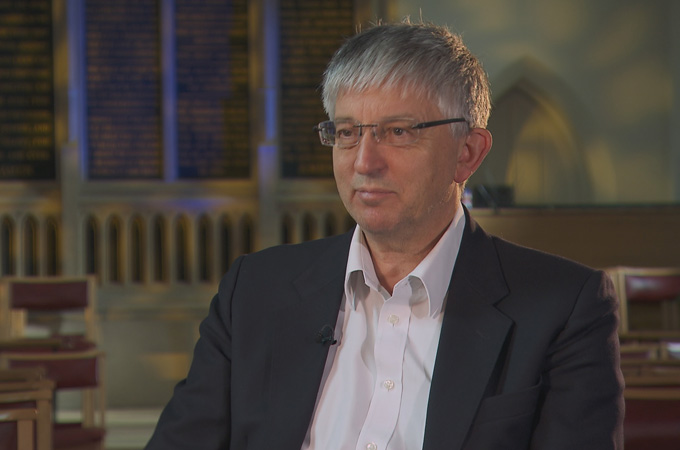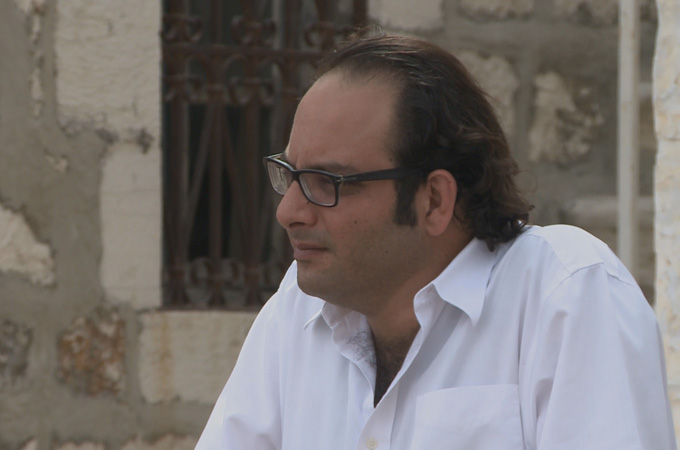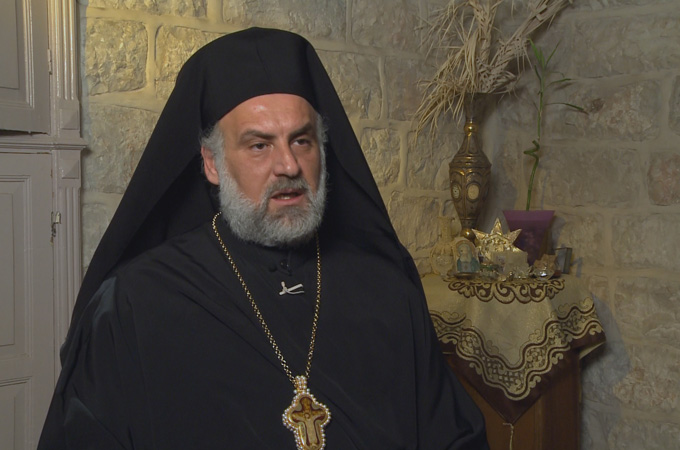
‘Whoever burns a church can kill people too’
Christians discuss the challenges they face in Israel and the Palestinian territories.
| Stephen Sizer, Anglican vicar |
 |
| “Sadly, I’ve seen pilgrimages that offer an opportunity to visit a settlement near Hebron where, for the day, you can pretend to be a member of the IDF, and you engage in mock conflict” [Al Jazeera] |
“Since 1967 the Israeli ministry of tourism has really exploited the Palestinian territories for their historical and archaeological locations and significance in the bible and so it produces maps which don’t show the international borders, don’t show the green line, but will show the Golan and West Bank as part of Israel.
The Israeli ministry of tourism has really exploited the Palestinian territories for their historical and archaeological locations and significance in the bible.
“The Israeli government clearly has an agenda to portray an Israeli script of the Holy Land. They will visit historical sites associated with the conquest of Palestine by the Israelites and perhaps a few locations that will help reinforce Israel’s insecurity or its need for the land that has been stolen from the Palestinians.
“I remember the first time I visited Israel/Palestine. I was quite nervous because of the stories I’d heard about the Palestinians. Our first guide was an Israeli Messianic Jew. On one occasion we were on the Via Dolorosa and we stopped for a few moments. People were asking him questions: ‘Can you please tell me what a Palestinian is?’ And he gave us all a little piece of paper that has been clearly prepared for such an occasion on which he was quoting Golda Meir, saying that Palestinians do not exist, they are Arabs and they can live somewhere else. A couple of days later we were in Nazareth and we met an Anglican cleric named Riah Abu El-Assal, and here we had our host introducing himself as a Palestinian Arab Christian.
“Sadly, I’ve seen pilgrimages that offer an opportunity to visit a settlement near Hebron where, for the day, you can pretend to be a member of the IDF [Israeli army], and you engage in mock conflict where they’ve built a little Palestinian village and you can go in and take out terrorists.
“This kind of commercial militaristic element of tourism is very worrying because it perpetuates this notion that the Palestinians are the enemy, rather than our brothers and sisters.
“Nazareth is very interesting; it could be a very interesting case study for tourism in Israel/Palestine, because it is in Israel but is largely an Arab city. So you visit Nazareth, you park down on the main road, you walk quite quickly up to the Church of Annunciation, so there is little or no opportunity even to shop, let alone engage with the local Christians.
“From an Israeli perspective, Palestinian tour guides are very dangerous. I think it was Ben Gurion who said he would rather have a Palestinian pilot flying an airplane over Israel than a Palestinian tour guide because, in his view, a Palestinian tour guide can do much more damage to the Israeli perspective than a fighter bomber.”
| Suheil Diab, spokesman for Nazareth Municipality |
 |
| “Successive Israeli governments never viewed these [papal] visits favourably because they highlight the ‘non-Jewish’ history of this land” [Al Jazeera] |
“Nazareth is a nuisance for the Israeli government, but they can’t erase its existence. They failed to do that after Al Nakba in 1948 due to global pressure.
Nazareth is a nuisance for the Israeli government, but they can't erase its existence.
“On the other hand, they want to demote the city’s status. In 1956, they established a big Jewish city, Nazaret Illit, to marginalise the Arabic and Palestinian city of Nazareth and turn it into a small district of the extended Jewish city. They aim to turn Nazareth into a quick one or two hour pilgrimage visit.
“To be clear, the successive Israeli governments never viewed these [papal] visits favourably because they highlight the ‘non-Jewish’ history of this land. They can’t prevent it, so they want to demote the role of Nazareth, Arabic Jerusalem and Bethlehem in such visits.
“[The 2009 papal visit] … was an intense struggle. The Israeli government placed hurdles. We said we’d do it on our own. When they finally decided not to exclude Nazareth, we submitted a comprehensive plan. They disputed every letter, every line, every date intensively to rule out Nazareth. It was clearly their political agenda. Our biggest challenge was time … we finished everything five days in advance.
“I was among the last people farewelling the Pope. I was waiting for this moment to reflect on our huge efforts. When the helicopter took off, a tape of all the memories rewound to prove that, since we pulled this off, we can do many great things.
“A group of Jews arrived from Jerusalem, used the main door. They approached the holiest part of the church, the ‘annunciation cave’, and placed explosive material. In few minutes thousands of Nazareth residents rushed to the church and put out the fire.”
| Fadi Qattan, Bethlehem tour operator |
 |
| “We witnessed Bethlehem being destroyed, its infrastructure ruined every day. In the tourism sector, we’re changing this status quo” [Al Jazeera] |
“Bethlehem is a special place for me. It represents the culture of Palestine. It’s a message to the world, whether religious or cultural, that regardless of the occupying force, we’re all co-existing in this land. This belief runs in our family. My parents and grandparents taught me to love Bethlehem.
“The second great thing about Bethlehem … is being the birthplace of the Lord Jesus. I look at Jesus and see the first non-violent example of resistance in the history of mankind.
“As a citizen of Bethlehem, I cannot tread Christ from north to south and visit the holy sites along the way. Since the start of the current apartheid regime in Palestine, starting with checkpoints and then the separation wall, none of the Palestinian Christians born in Bethlehem can tread the historical footsteps of Jesus Christ.
“Israel issues permits to Christians during religious holidays only and tells the world it’s running a democracy by allowing some Christians to reach their holy places. But they mostly issue a permit to one family member and ignore the rest.
In a religious holiday no one would celebrate and pray alone and leave their family behind.
“The Lepers Church in Burqin and Jacob’s Well in Nablus are in Palestinian territories. They remain underdeveloped. Israeli tourist agencies neglect these locations, because they are now situated behind the separation wall.
The pilgrims are taught to be afraid of the locals and they have no opportunity to break this barrier and interact with the natives.
“Pilgrimage can’t be partitioned. It has to be respected, rich and complete. Israeli agencies search for more profits, thus neglecting major pilgrimage milestones. Some Israeli pilgrimage tours include three days in Eilat, which is a resort city by the Red Sea. It’s not of any value to a Christian pilgrim and is a four-hour drive south of Jerusalem, which makes it a five-day trip. Most pilgrims spend 10 to 12 days in the Holy Land. If they waste three nights in Eilat, and two days to travel back and forth, then what’s the expense?
“The 2001 invasion of Bethlehem was probably one of the harshest times the city had to undergo. Occupation forces invaded Bethlehem, imposed a curfew and also sieged the Nativity Church when fugitives hid inside. The siege was humiliating for such a holy place. They fired live ammunition at the church, and priests held captive inside had their rooms shot at and windows broken. The church bell-ringer was up the tower trying to ring the bells when an Israeli sniper killed him.
“After the siege ended and things went back to normal, the tourist bus would reach the Bethlehem checkpoint and there the Israelis would claim there was a security hazard. The pilgrims were forced to go back to Jerusalem, while nothing was going on. It was perfectly normal in Bethlehem. Most tourists spend very limited time in the city. They spend 45 minutes to two hours. The city reaps no economic benefits.
“Even worse, the pilgrims are taught to be afraid of the locals and they have no opportunity to break this barrier and interact with the natives.
“In Cremisan Valley, Beit Jala. there are two monasteries, one for priests and one for nuns. The area is surrounded by two settlements: Gilo and Har Gilo. The Israelis plan to build the separation wall on lands owned by the church and local Palestinians, as well as separating the monasteries.
“Every Friday afternoon Christians and Muslims join for afternoon mass. It was started by the locals from Beit Jala, Bethlehem and Beit Sahour. We know how to demand our rights peacefully in the face of a non-peaceful occupation.
“My office is in the centre of Bethlehem downstairs from my home. I realise that I live within contradictions. At one hand I’m trying to keep contacts with foreign agencies to send me pilgrims to Bethlehem. Yet, I see the whole world is indifferent to our plight. We witnessed Bethlehem being destroyed, its infrastructure ruined every day. In the tourism sector, we’re changing this status quo. We travel to foreign exhibitions and meet agencies. We help pilgrims affiliate with the local churches and communities. We arrange scout gatherings and meetings with the city mayor. Israeli tourism agencies don’t do this. In their tours the pilgrims spend only around 45 minutes in Bethlehem.
We help introduce a spiritually complete experience. When a person lives in occupation and behind a wall he’s forced to get a permit that frees him from this prison. People are however aware that asking for a permit to exercise their religious right is all about humiliation.”
| Milatios Basal, head of Saint Joachim and Anne monastery in Jerusalem |
 |
| “I was prohibited from entering the Resurrection Church many times although I am a local priest. The real goal is not security” [Al Jazeera] |
“Since the dawn of Christianity, the early centuries were associated with persecution. The first persecution being crucifying Jesus Christ. Christianity in its essence invalidates Judaism. Since the very beginning Jews were hostile towards early believers. It was physical abuse rather than psychological. Many who converted to Christianity were killed and martyrdom was at its highest rates at the early centuries. As a result, Christians hid and prayed in catacombs or cemeteries.
“Pilgrims are of two types: locals and foreigners. The foreigners come from Russia, Romania, Italy …. Often, one wakes up to find an emigration form signed by the ambassador or the consul at his doorstep. Just fill your name and post it. They don’t want any Christian here; neither a visitor nor a resident. Foreign pilgrims bring a huge income but it’s not an economy the Israelis are concerned about. They don’t want Palestine to be a Christian sanctuary. They want to transform it into a Jewish land.
“We can’t be exact about the real baptism location but we know that it’s near Jericho. Until the 1980s Israelis tried to overshadow the baptism original place in the media. They planted a small place near the Sea of Galilee and called it ‘Yardenit’ in Hebrew. Thus implying that the actual place is near the Sea of Galilee.
The foreign pilgrim guides are taught to coordinate with the army to visit the baptism site. I find this appalling considering the site is part of the West Bank and is classified as a Palestinian area under the Oslo Accords.
“In fact, Yardenit has no biblical or historic connection to the baptism of Jesus. It was established for tourism purposes. It’s financially lucrative.
“And at the end of the 1990s, Jordan started to show interest in the baptism site. They wanted to revive Jordan as a holy land and started excavating with the help of historians and archaeologists. The Israelis decided to change plans.
“They initially kept the place closed to Christian pilgrims to fulfil their religious agenda. The Old Testament states it’s the place that Joshua crossed holding the arc of the covenant. They want to erase any Christian linkage to the place and turn it into a synagogue. They even call it ‘Palace of the Jews’.
“The foreign pilgrim guides are taught to coordinate with the army to visit the baptism site. I find this appalling considering the site is part of the West Bank and is classified as a Palestinian area under the Oslo Accords. Yet, the Israeli army controls the land and prohibits Palestinians holding green IDs from entering. It’s shameful to block a pilgrimage site.
“Qilt Valley is part of the Palestinian Jericho municipality. In today’s terms it falls into the ‘C’ areas controlled by the Israeli army. Its secluded monastery has certain significance. Prophet Elijah worshiped there for a long time. Saint Joachim, Virgin Mary’s father, secluded there and asked God for a child and thus came Mary. The Israeli regime tried frequently to evict the priests through psychological persecution such as depriving them of water. They’re not prohibited by the army to use an ancient well located there.
“Another issue is Holy Saturday. The church of resurrection yard becomes a military barracks. Even priests aren’t allowed to move freely. They claim it is for security. Security is used as an excuse to forbid believers from entering the church. Jewish Passover occurs in the same period. More than half-a-million enter the same area and they set up no checkpoints. Jews are usually the terrified ones, but suddenly security is not essential during their holidays anymore?
“I was prohibited from entering the Resurrection Church many times although I am a local priest. The real goal is not security. Easter used to fill Jerusalem with Christian pilgrims. The Israeli authorities resent this. They don’t want Jerusalem to be a Christian beacon.
“Persecution, of course, did not cease. To this day there is persecution, not necessarily physical but psychological aiming at the psyche and personality. Persecution, although continuous, intensifies sometimes.”
| Atallah Hannah, archbishop of Sebastia Orthodox Church |
 |
| “Whoever burns a church can kill and can assault religious symbols and people too” [Al Jazeera] |
“The Palestinians, whether Christian or Muslim, are deprived of visiting the holy sites in Jerusalem. When I visit Bethlehem, Beit Jala or other Palestinian cities, youth approach me to say: ‘Our Father, Our Bishop, we’ve never seen Jerusalem.’
Before we discuss overseas visitors, our priority is Palestinians, the original people of this land.
“So before we discuss overseas visitors, our priority is Palestinians, the original people of this land.
“The Israeli ministry of tourism seeks to avoid contact between the pilgrims and any Palestinian figure. Israel prevents such contact because they won’t allow the Palestinian Christian point of view to be heard regarding what’s taking place in Jerusalem and the Palestinian territories.
“Whoever burns a church can kill and can assault religious symbols and people too.
“Every day in Jerusalem we are loathed, spat at and insulted. Foreign priests and pilgrims are insulted by extreme fanatic Jews. Those who insult could assault and hurt and may actually do even worse. I think silence will result in these crimes being repeated. That’s why we are still witnessing new incidents. I believe there are factions in the Israeli government supporting those extremists. It is not a fanatic group issue. Extremists are being supported by government figures. When some Israeli ministers speak, their language is as violent and racist as those who attack the churches.
“In Latrun Monastery there was a key development. Graffiti vandalism did not suffice; they also burnt part of the monastery. If it wasn’t for the vigilance of the priests in the early morning, the whole monastery would have been burnt. Thank God there were no human losses. So far, we have heard of no arrests connected to those crimes.”
Watch more on Forbidden Pilgrimage
Al Jazeera World can be seen each week at the following times GMT: Tuesday: 2000; Wednesday: 1200; Thursday: 0100; Friday: 0600; Saturday: 2000; Sunday: 1200; Monday: 0100; Tuesday: 0600. Click here for more Al Jazeera World. |
